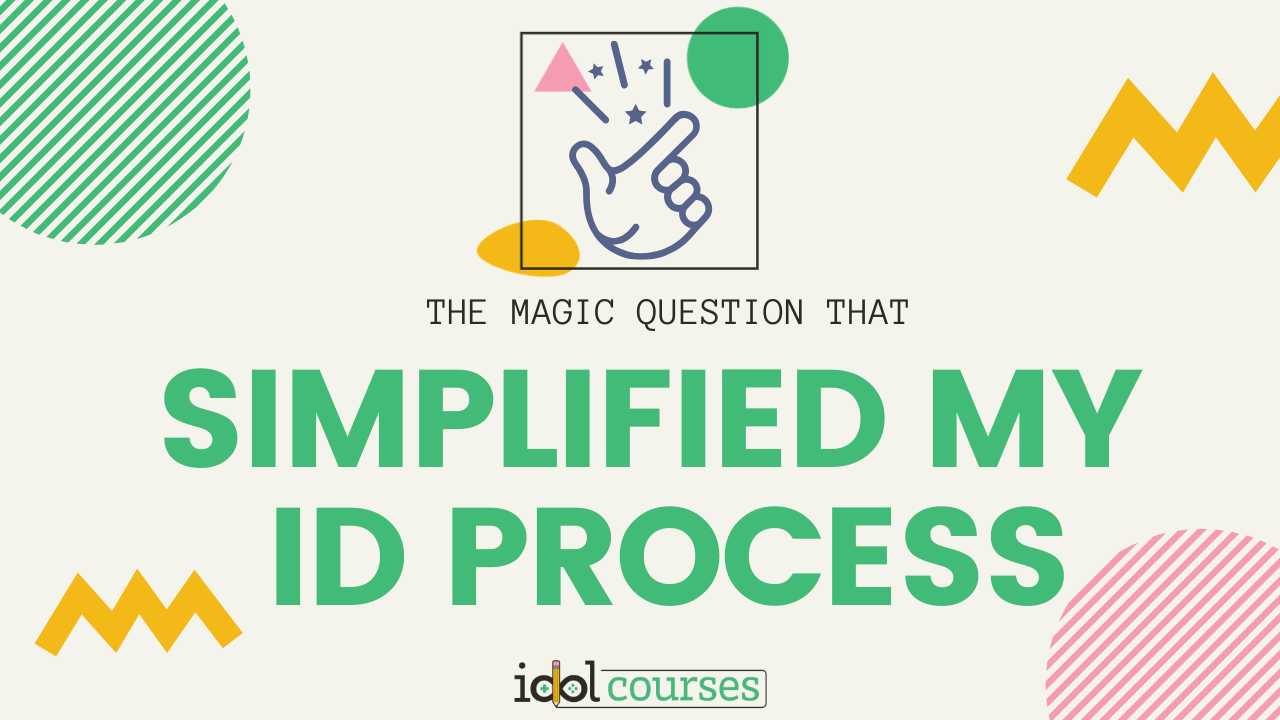The Magic Question that Simplified my ID Process
Jun 11, 2020
You are starting on a new instructional design project and just read the project outline. You are half-excited and half-worried that you may not meet expectations. You decide to silence that voice first. You get into your design space, and you start thinking: Okay, I got the learning outcomes, and the intended business goals but:
- I should probably follow what's on the books this time.
- "A" from ADDIE. That's my lifesaver.
- Let me google first what others might have done. It isn’t cheating because I am just looking for some inspiration. ;)
Let's face it. If you have done your instructional design homework, you have probably concluded there are a LOT of ID frameworks out there. As part of the IDOL courses Academy, I got to take a dive into the 7 most commonly used instructional design models.
I thought : "That's it! I got into the backstage, got the tricks of the trade now, let me start designing and developing." I quickly realized I should be very selective in how I incorporated those models in my workflow. It wasn't until I got to work on my first corporate ID project when I developed a secret formula. This formula cleared my mind and took off the constant self-doubt rumination of whether I was doing something wrong if I was not following X, Y, Z ID model religiously. The secret formula is a question that I kept asking myself whenever I felt stuck, especially in the early stages of ID projects ( the i.e., analysis Phase).
What kind of content are you dealing with, Nada?
It was a small question, but so powerful. It put my thinking process into perspective while keeping the 7 ID models in the back of my mind as reassurance and point of reference. Pretty much like a toolbox you know is hidden somewhere in your house, and it reassures you to know that you have access to it whenever you need to.
This question became a thinking habit whenever my design mode was on, and it came to life after I read Ruth Clark's powerful book: Developing Technical Training: A proven approach for developing classroom and computer-based instructional material. Here is the thing. There are only 5 possibilities of content I could be faced with. Just this thought was relieving and helped my monkey mind focus. The five types of content are the following: facts, principles, procedures, processes, and concepts.
Content-Type #1 : Facts
Facts are pieces of content that happen to be unique. All their instances are the same. What's unique about facts is they must be held individually in memory. There aren't some big ideas (concepts) that help categorize them under one umbrella. Facts cannot be transformed. Facts are best designed in diagrams, infographics, tables, and bulleted lists.
Content-Type #2 : Processes
Processes are my favorite because I get to ask myself when in doubt this simple question: Are you explaining how a thing or system works? They give you a holistic overview perspective of those systems. Processes are big picture content. They are descriptive in nature. They usually work best when included in flow diagrams (linear or circular) and process tables.
Content-Type #3: Procedures
On the other hand, procedures are made up of steps and actions that the trainee needs to take. When your content is a procedure, you will usually see that it is logical to make trainees perform steps following directives. Procedures are in their best instructional format when presented in video tutorials, or narrated screen captures. In face-to-face environments, they are usually in the form of instructor step-action demonstrations.
Content-Type #4: Principles
Principles exist because some tasks do not involve procedures or steps that are precise as they depend upon context and subjectivity of the person, their personality, and how they incorporate feedback and experience into that task. Principles generally involve social skills and are not precise or scientific. An example would be how a top-performing salesperson closes a sale applying the selling best-practices. They are not exact because each person will apply principles differently depending on situations.
Content-Type #5 : Concepts
Concepts are abstract ideas. Every concept has must-have features and irrelevant features. Concepts are usually taught through a definition followed by examples, counter-examples, and analogies. This robust thought process can help any learning designer out there who feels puzzled when about to decide on the kind of route their design should be taking.
Next time you are feeling overwhelmed an ID concept, don't panic…….. stop for a moment, breathe then ask yourself …. What kind of content are you dealing with? When you have identified the content type you will be able to figure out the best presentation to meet the learning out come and business goals.
Written by: Nada El Maliki

Nada is a proud IDOL courses Academy alumnus. She is a passionate learning designer and developer. She loves to share tips and tricks with learning designers through her blog and youtube channel. Connect with Nada on LinkedIn.
Stay connected with news and updates!
Join our mailing list to receive the latest news and updates from our team.
Don't worry, your information will not be shared.
We hate SPAM. We will never sell your information, for any reason.


